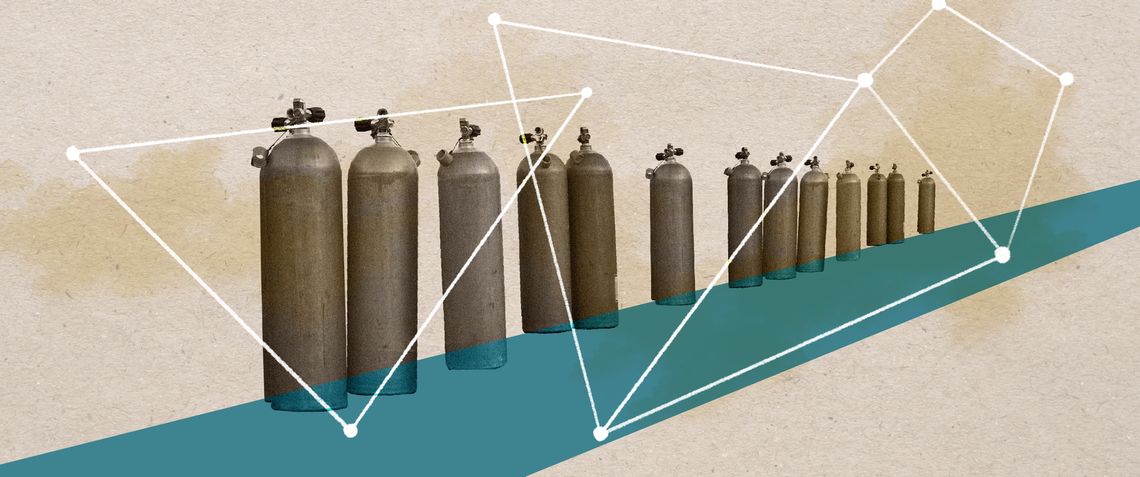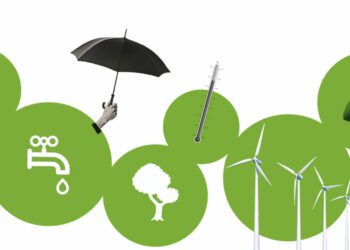

On December 31, 2020, the Southern Gas Corridor (SGC) enabled the first direct shipments of Azerbaijani natural gas to the European Union. The event has great importance for the future, as EU countries are still dependent on Russia to meet their demand for natural gas.
Fossil Fuels Are Not Created Equal
Unlike oil, natural gas is not efficiently transported over oceans; new liquefied natural gas (LNG) techniques have made advances in this area, but still add significant expense. Thus, natural gas markets are regional, unlike the oil market, which is global.
In 2006, the Baku-Tbilisi-Ceyhan (BTC) crude oil pipeline was completed, allowing Azerbaijani oil to be loaded onto tankers on the Mediterranean coast and reach global markets. That same year, the Baku-Tbilisi-Erzurum (BTE) natural gas pipeline, also began to supply Georgia and Turkey. These two projects formed the backbone of the Turkey-Georgia-Azerbaijan regional triangle. Any Azerbaijani natural gas that reached Europe, however, would have to flow through Russia, likely via Ukraine or Belarus. The same is true for natural gas from the Central Asian countries on the east side of the Caspian Sea.
As a result, 40% of the EU’s natural gas imports came from Russia in the first quarter of 2020.
SGC Gas Recipients
The Southern Gas Corridor project expands the capacity of the BTE pipeline (also called the South Caucasus pipeline) and connects it to a new Trans-Anatolian Pipeline (TANAP) traversing the length of Turkey, and Trans-Adriatic Pipeline (TAP), across northern Greece, Albania and under the Adriatic Sea to the southern Italian town of Melendugno.
The total capacity of the new east-west corridor will now be 16 billion cubic meters (bcm) per year. From this amount, Turkey will be entitled to 6 bcm, Italy will get 8 bcm, and Greece and Bulgaria will receive 1 bcm each.
It will be sourced from Azerbaijan’s Shah Deniz gas field but also opens up the possibility of future supplies from Central Asia if the pipeline is later extended across the Caspian Sea.
Contributions to Climate Change
The operation of another gas corridor runs counter to the priorities of the European Green Deal and the EU’s 2050 Energy Strategy, however. The ambitious goal of the European Green Deal is to become climate-neutral by 2050, requiring that zero net new greenhouse gases are emitted after that date. First, it is expected to reduce emissions to 50% of 1990 levels by 2030. Over 75% of the EU’s greenhouse gas emissions come from the production and consumption of energy. According to the EU’s 2050 Energy Strategy, the long-term role of gas may be limited to providing a flexible backup and balancing capacity, as renewable energy supplies have a variable nature. The operation of a new pipeline contradicts the road map given in the strategy. Some NGOs see the links between the Aliyev family and British Petroleum (BP) as a lobby in favor of gas, despite the potential of declining demand within the framework of the Green Deal.
From an environmental point of view, the SGC’s negative impact toward climate change is equal to the usage of coal mainly because of fugitive emissions of uncombusted methane and other leaks which are a particularly potent greenhouse gas that is more damaging than carbon dioxide.
Potential to Be Co-opted by Russia
However, the biggest argument of the European Commission that the pipeline will reduce dependence on Russian gas imports is a weak one. Considered one of the EU’s “highest energy securities priorities,” the SGC initially should provide 10-20 percent of Europe’s gas demand. However, the 10 bcm it will supply the EU makes up only about 2 percent of the EU’s annual demand.
While engaging other countries with extensive gas reserves (like Turkmenistan or Iran) could increase that number, this is not likely to happen for the foreseeable future. According to the Oxford Institute for Energy Studies, first gas began to be produced equal to 16 bcm; it is expected to go into natural decline in 2030, falling to about 6 bcm in 2035. Moreover, Russia’s energy giant Lukoil maintains a 10 percent share of the Shah Deniz consortium, which is the gas provider of the Southern gas corridor. Gazprom indicated that it is considering selling its own gas through the TAP, which critics say would be contradictory to the main point of the project. Such transit could be possible because of an auction system, which gives equal access to all potential suppliers.
Inconsistent With EU Values
A report by CEE Bankwatch Network[1] revealed that 15 firms involved in the construction of the two main new sections of the Southern Gas Corridor, TANAP and TAP, have been involved in different corruption scandals in the past or have connections to mafia groups. For instance, in Italy 3 of the companies involved in the construction of the pipeline had connections with mafia groups. And another one has been convicted for corruption in front of Italian courts.
Initially, President Ilham Aliyev of Azerbaijan wanted SOCAR to finance the whole project. However, falling oil prices made him apply to Western partners and international financial institutions like the World Bank, Asian Development Bank, European Investment Bank and the European Bank for Reconstruction and Development (EBRD).
As a result of this investment, one of the conditions on Azerbaijan is to follow standards of the Extractive Industry Transparency Initiative (EITI). The platform requires representatives of governments, civil society and businesses to cooperate in making transparency and accountability reforms in the extractive industry. However, in April 2015, the EITI Board lowered the status of Azerbaijan from “member” to “candidate,” taking into account the unprecedented persecution of civil society representatives in 2013-2014. The Arab Spring and Ukraine’s Maidan Revolution had led the Aliyev family to suppress civil society and the main opposition, fearing that his dynasty might be removed from power. As a result, several influential NGOs were closed, the law on grants was changed, and many journalists and public figures were imprisoned or left the country. During that period, the NGOs involved in the EITI platform wrote a joint letter calling on the Board to pressure the Azerbaijani government to let up its oppressive tactics. The Board gave Azerbaijan a four-month deadline to reform restrictive legislation that paralyzed the operations of civil society in the country. In 2017, instead of ameliorating its human rights record and meeting the criteria, Azerbaijan quit the EITI. The EU could have demanded that the Azerbaijani government improve transparency in order to qualify for financial support toward the SGC’s construction. However, this did not happen; the EBRD didn’t keep the arrangement and allocated a loan to the SGC anyway.
Engagement is a good strategy if the goal is to bring about change. The EU’s cooperation with such a regime, which actually scores lower than Russia in Freedom House rankings, actually entrenches it, making the work of civil society interested in bringing real change even harder. The move also casts into doubt the EU’s commitment to its declared values and tarnishes its image of normative power.
EU Strategic Partnership
Azerbaijan is the Eastern Partnership country with which the EU tries to cooperate only in specific spheres. The relationship is based mainly on pragmatic grounds. The EU sees Azerbaijan as a strategic partner in terms of ensuring energy imports. Azerbaijan seeks to limit the scope of this cooperation to the economic dimension, without accompanying political requirements. Any conditions from the EU side are met with severe criticism by the Azerbaijani government. In 2015, the European Parliament adopted Resolution 2015/2840, which put negotiations for a new agreement on hold and requested the introduction of targeted sanctions on officials and judges until the country began to take human rights more seriously. Instead of turning attention toward human rights, Azerbaijan took aim at the resolution itself. Despite the European Parliament’s call, the EU started negotiations with Azerbaijan without preconditions.
In July 2018, the European Parliament’s recommendation to negotiators working on the EU-Azerbaijan Comprehensive Agreement passed by 564 votes to 69, with 47 abstentions. It calls on the EU Council, EU Commission and the EU foreign policy chief to pay attention to the human rights violations respecting democracy, the rule of law, good governance, human rights and fundamental freedoms. Moreover, in the 17th Cooperation Council meeting between the European Union and the Republic of Azerbaijan held in Brussels on December 18, 2020, High Representative of the European Union for Foreign Affairs and Security Policy Josep Borrell announced: “The EU wants to conclude an ambitious new comprehensive agreement with Azerbaijan, based on democracy, human rights and fundamental freedoms. This would contribute to the diversification of Azerbaijan’s economy, enhance our trading relationship and extend our cooperation more broadly.”
Whenever the EU brings up reforms with Azerbaijan, the autocratic government of that country plays the energy card and sidesteps the issue. Perhaps, it is the result of good lobbying that Azerbaijan is depicted as a strategic partner of the EU and an alternative to Russian energy dependence. However, the EU has a powerful card that it never plays. Just as the EU depends on Azerbaijani gas supplies, by the same token Azerbaijan depends on the EU as a central market. The EU as a market for Azerbaijan is indispensable. Otherwise, Azerbaijan could only sell its gas to Georgia and Turkey. The deal is mutually beneficial.
The operation of the SGC raises the geopolitical significance of Azerbaijan and Turkey, and contributes to the further isolation of Armenia from regional projects. The EU seems to limit its concern about human rights violations and war crimes in Artsakh to mere lip service. As a result, the actions also have a corrosive effect on the democratic process in Armenia, where an emboldened narrative of unquestioned commitment to Russia and the “dangers” posed by democratization have gained momentum since the 2020 Artsakh War.
——————————
1- CEE Bankwatch Network is the largest network of grassroots, environmental and human rights groups in Central and Eastern Europe that monitors public finance institutions responsible for hundreds of billions of investments across the globe.
The Turkey-Georgia-Azerbaijan Regional Triangle
Turkey, Georgia and Azerbaijan institutionalized their triangle long before the 2020 Artsakh War and have established deep roots of cooperation.
Read moreThe European Green Deal and Its Implications for Armenia
The European Green Deal is an ambitious plan to make Europe the first climate-neutral continent by 2050. Anna Barseghyan looks at the challenges and opportunities for green policy in Armenia.
Read moreArmenia in a Post-Oil Era
The nature of the strategic importance of oil and gas is changing. As energy policies adapt, Armenia will face a new global reality. Will it be ready for it?
Read moreUnderstanding the Region: Energy in the South Caucasus
Once-integrated energy channels were disrupted with the fragmentation of the Soviet Union, Armenia, Azerbaijan and Georgia began rebuilding their impaired energy infrastructures. How have these countries with different degrees of European and Russian influence and different energy needs and natural oil and gas reserves fared so far and what do they have in common?
Read more




